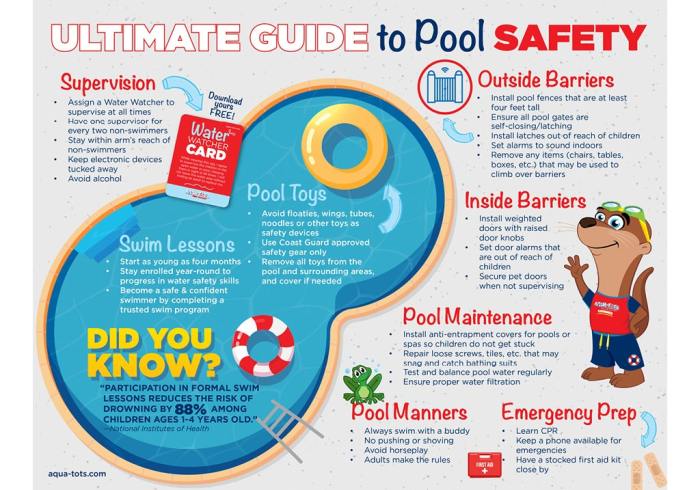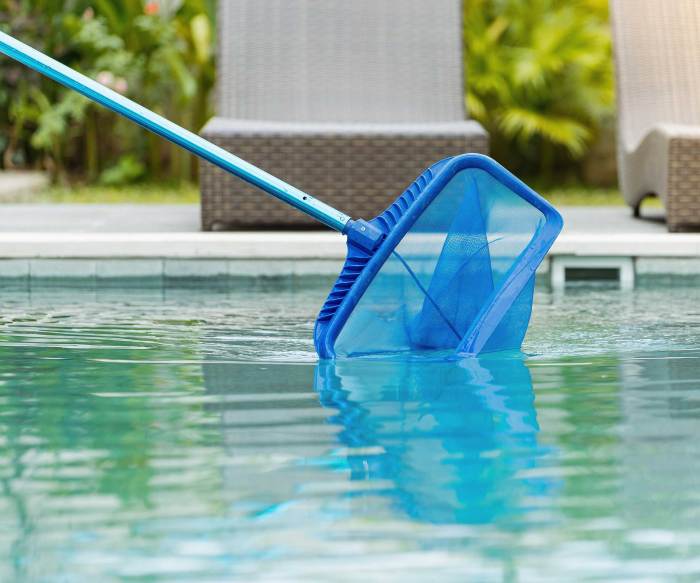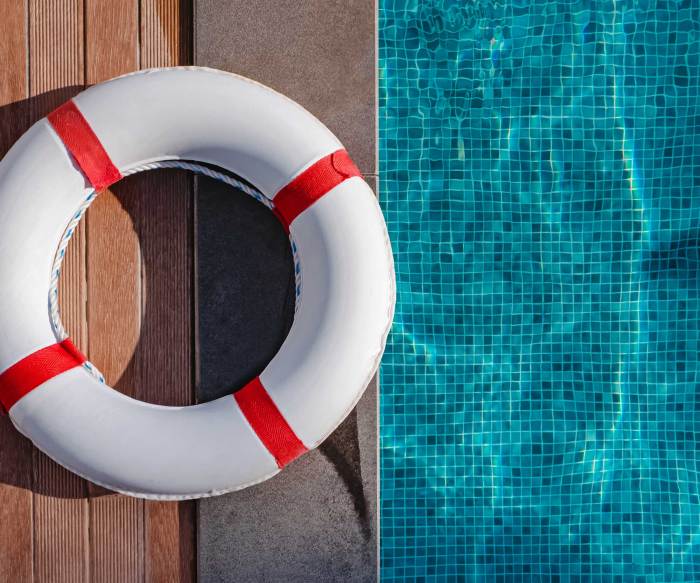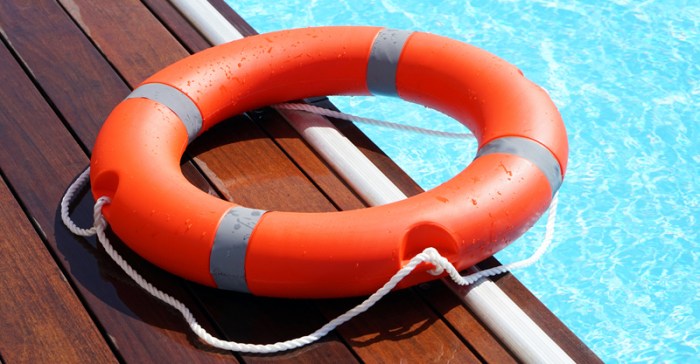Drowning Prevention

Source: torontopoolsupplies.ca
Backyard pool safety tips – Drowning is a silent killer, often happening quickly and without warning. Preventing drowning in backyard pools requires a multi-layered approach, combining constant vigilance, effective barriers, and proactive safety measures. This section Artikels key strategies to significantly reduce the risk of drowning accidents.
Effective Drowning Prevention Methods
Implementing multiple layers of protection is crucial for effective drowning prevention. A single method is insufficient; a combination offers the strongest defense. The following table Artikels some of the most effective methods:
| Method | Effectiveness | Implementation | Considerations |
|---|---|---|---|
| Constant Adult Supervision | Highly Effective; the most crucial factor | Dedicated, attentive adult within arm’s reach of children at all times. No distractions (phones, reading, etc.). | Requires consistent commitment and awareness. Even brief lapses can be fatal. |
| Pool Fencing | Very Effective; creates a physical barrier | Four-sided fence at least 4 feet high, self-closing and self-latching gate, gate located away from the pool’s edge. | Regular inspections for damage and proper functioning of the gate are essential. |
| Pool Cover | Moderately Effective; prevents access but not foolproof | Secure, heavy-duty cover that meets safety standards. Regular checks for tears or damage. | Covers can be dislodged or fail under certain conditions. Never rely solely on a pool cover. |
| Swimming Lessons | Moderately Effective; teaches survival skills | Enroll children in age-appropriate swimming lessons from a qualified instructor. | Lessons are not a substitute for supervision; they empower children but do not eliminate risk. |
Constant Adult Supervision
Constant and attentive adult supervision is the single most effective method of preventing drowning. This means a designated, responsible adult should be within arm’s reach of children at all times while they are in or around the pool area. No distractions, such as cell phones, reading, or conversations, should interfere with this crucial responsibility. Implementing a “buddy system” where adults take turns supervising can help ensure consistent vigilance.
Rotating supervision responsibilities can also prevent fatigue and maintain alertness. A clear understanding of who is responsible at any given time is essential.
Pool Safety Barriers
Various barriers can significantly reduce unsupervised access to pools. Each has benefits and drawbacks:
- Fences: Offer strong physical protection when properly installed and maintained. However, they require regular inspection for damage and ensure the gate is self-closing and self-latching.
- Gates: Self-closing and self-latching gates are critical to prevent accidental access. Regular checks to ensure proper functioning are essential.
- Pool Covers: Provide a layer of protection, but should never be relied upon as the sole safety measure. They can be dislodged or fail, and are not a substitute for supervision.
Pool Safety Checklist
This checklist should be completed before and after each use of the pool:
- Before Pool Use: Check pool fence for damage and gate for proper latching. Ensure pool cover is securely in place (if used). Designate a responsible adult supervisor. Have all necessary safety equipment (e.g., life rings, shepherd’s hook) readily accessible.
- After Pool Use: Secure the pool cover (if used). Check the area for any debris or hazards. Ensure the gate is properly latched. Clean and maintain the pool equipment.
Safe Pool Access and Exits

Source: aqua-tots.com
Easy and clearly marked access and exits are crucial for pool safety. Quick escape routes are essential in case of accidental falls or emergencies. Properly designed and maintained access points significantly reduce the risk of injuries and drowning.
Ensuring safe and easy access to and from your pool is paramount. This involves more than just having a ladder; it’s about thoughtful design and regular maintenance to prevent accidents. Clear pathways, well-maintained ladders, and non-slip surfaces all contribute to a safer swimming environment.
Pool Ladder and Step Requirements
Safe pool ladders and steps are vital for convenient and safe entry and exit. They should be made from durable, corrosion-resistant materials like stainless steel or high-quality plastic, capable of withstanding constant exposure to water and chemicals. The design should include wide, non-slip steps or treads with sufficient space between them for comfortable footing, even when wet. Handrails on both sides are essential, especially for children and older adults, providing extra support and stability.
Regular inspections for rust, loose bolts, or damaged steps are crucial for maintaining safety. Ladders should be securely anchored to the pool deck and the pool itself to prevent shifting or tipping.
Non-Slip Surfaces Around the Pool
Slippery surfaces are a major contributor to poolside accidents. To mitigate this risk, non-slip surfaces are essential around the entire pool area, including walkways, decks, and steps. Suitable materials include textured concrete, anti-slip tiles, and specialized non-slip coatings applied to existing surfaces. These materials offer increased traction, even when wet, significantly reducing the risk of slips and falls.
Proper installation is crucial; ensure the chosen material is correctly laid to avoid uneven surfaces or gaps that could trap water and increase slipperiness. Regular cleaning and maintenance will also help maintain the effectiveness of the non-slip surfaces.
Securing a Pool Cover
Properly securing a pool cover is critical to prevent accidental access, especially for young children. Before securing the cover, ensure the pool area is completely clear of any debris or obstacles. Choose a pool cover designed for your pool type and size. Most covers utilize straps, clips, or weights to secure them tightly. Follow the manufacturer’s instructions carefully to ensure the cover is correctly installed and fastened.
Regularly check the cover for any signs of wear or damage, and replace it if necessary. Remember, a properly secured pool cover acts as a crucial safety barrier, preventing unsupervised access to the pool.
Emergency Preparedness

Source: futurecdn.net
A well-defined emergency plan is crucial for ensuring the safety of everyone around your pool. Knowing what to do in a pool-related emergency can significantly reduce the risk of serious injury or even death. This section Artikels a step-by-step plan, including essential life support techniques and hazard mitigation strategies.
Emergency Response Plan
Responding to a pool emergency requires swift and coordinated action. The first step is always to assess the situation and ensure your own safety before attempting a rescue. Then, immediately remove the victim from the water, prioritizing their airway, breathing, and circulation.
- Assess the Scene: Check for immediate dangers before approaching the victim. Is the water electrically charged? Are there sharp objects or unstable surfaces? Ensure your own safety before acting.
- Rescue the Victim: If possible, use a reaching assist (e.g., a long pole or branch) or throwing assist (e.g., a flotation device). Only enter the water if absolutely necessary and you are trained in water rescue techniques. Avoid direct contact if the victim is unconscious or exhibiting erratic behavior.
- Remove from Water: Once the victim is safely out of the water, carefully lay them on a flat surface. Begin CPR immediately if they are unresponsive and not breathing normally.
- CPR and Rescue Breathing: Administer CPR according to your training. If you are not CPR-certified, focus on rescue breathing until emergency medical services arrive.
- Call Emergency Services: Call your local emergency number (911 in the US) immediately. Provide clear and concise information, including the location, the number of victims, and the nature of the emergency. Remain on the line until instructed otherwise.
Basic Life Support Techniques
Knowing basic life support (BLS) techniques, including CPR and rescue breathing, can be lifesaving in a pool emergency. These techniques should be learned through a certified course, such as those offered by the American Red Cross or the American Heart Association. The following table provides a simplified overview; however, formal training is essential.
| CPR (Cardiopulmonary Resuscitation) | Rescue Breathing |
|---|---|
| 1. Check for responsiveness. If unresponsive, call emergency services and begin CPR. | 1. Check for responsiveness and breathing. If not breathing normally, begin rescue breathing. |
| 2. Give chest compressions at a rate of 100-120 compressions per minute, pushing hard and fast. | 2. Give two rescue breaths, each lasting about 1 second. Ensure a good seal around the victim’s mouth. |
| 3. Give rescue breaths after every 30 compressions. | 3. Continue rescue breaths until emergency medical services arrive or the victim starts breathing normally. |
| 4. Continue CPR until emergency medical services arrive or the victim shows signs of life. | 4. Monitor the victim’s breathing and responsiveness. |
Pool Area Hazard Mitigation
Several hazards exist around pools that can contribute to accidents. Proactive measures can significantly reduce these risks.
- Slippery Surfaces: Regularly clean and dry pool decks. Use non-slip mats or surfaces where appropriate. Avoid walking on wet surfaces if possible.
- Electrical Outlets: Ensure all electrical outlets are protected by ground fault circuit interrupters (GFCIs) and are located away from water sources. Keep electrical equipment away from the pool area.
- Sharp Objects: Keep sharp objects (e.g., broken glass, tools) away from the pool area. Regularly inspect the pool deck and surrounding areas for potential hazards.
- Unsecured Pool Covers: Ensure pool covers are properly secured and maintained to prevent accidents.
Emergency Equipment Placement
A clear visual representation of emergency equipment placement is crucial. This image depicts a pool area with strategically placed equipment for quick access in an emergency.
Visual Aid Description: Imagine a rectangular pool surrounded by a concrete deck. At the corner closest to the house, a clearly labeled first-aid kit is mounted on the wall inside a weatherproof box. On the opposite corner, a bright yellow life ring is mounted on a sturdy, easily accessible post. A shepherd’s hook with a rescue tube hangs near the life ring.
A telephone, clearly marked for emergency calls only, is located on the wall near the first-aid kit. The entire area is well-lit.
Child Safety Measures

Source: futurecdn.net
Keeping young children safe around a pool requires constant vigilance and a multi-layered approach. It’s not enough to rely on just one safety feature; a combination of strategies is crucial to minimize the risk of accidental drowning. This section will Artikel essential safety measures specifically designed for households with children.
Teaching children to swim is one of the most effective ways to reduce their risk of drowning. Early swimming lessons, ideally starting as young as possible (but always with age-appropriate instruction), provide children with essential water safety skills and increase their confidence and comfort in the water. These skills empower them to handle unexpected situations and potentially self-rescue if they fall in.
The benefits extend beyond just survival; swimming lessons foster physical fitness, coordination, and self-esteem.
Pool Alarms
Pool alarms are designed to alert you to unauthorized pool access. Different types exist, each with varying levels of effectiveness. For instance, some alarms are triggered by water movement, while others detect entry into the pool area. Door alarms placed on access points to the pool area provide an audible warning if a child opens a door leading to the pool.
Submersible alarms are placed in the water and trigger when someone falls in. While all alarms offer some level of protection, it’s important to note that no alarm is foolproof, and they should be considered a supplementary safety measure, not a replacement for constant supervision. Regular testing and maintenance are vital to ensure their functionality.
Pool Rules for Children
It is crucial to establish clear and simple pool rules for children and ensure they understand and follow them. These rules should be displayed prominently near the pool area, ideally in a visually appealing and easy-to-understand format.
Here’s a sample list of rules:
- Never swim alone. Always have an adult present.
- Ask a grown-up before entering the pool area.
- No running or horseplay near the pool.
- Never push or jump on others in the pool.
- Always listen to the adult supervising the pool.
- Do not use flotation devices without adult supervision.
- Immediately exit the pool if instructed to do so by an adult.
- Learn how to swim.
Pool Maintenance and Chemical Safety: Backyard Pool Safety Tips
Keeping your pool clean and chemically balanced is crucial not only for a pleasant swimming experience but also for the safety of everyone using it. Improperly maintained pool water can lead to skin and eye irritation, and unbalanced chemicals can pose serious health risks. Understanding proper pool maintenance and chemical handling is vital for responsible pool ownership.Proper water chemistry ensures a safe and enjoyable swimming environment.
Regular testing and adjustments are essential to maintain the correct balance of chemicals. Neglecting this can result in cloudy water, algae growth, and corrosion of pool equipment. Furthermore, improper chemical handling can lead to serious accidents, including chemical burns and respiratory problems.
Water Chemistry Testing and Balancing
Regular testing of your pool water is paramount. Use a reliable test kit to measure the levels of chlorine, pH, alkalinity, and calcium hardness. These parameters need to fall within specific ranges to ensure safe and healthy swimming conditions. The ideal chlorine level is typically between 1 and 3 parts per million (ppm), while the pH should be between 7.2 and 7.8.
Alkalinity should be between 80 and 120 ppm, and calcium hardness should be between 200 and 400 ppm. Adjusting these levels requires the careful addition of appropriate chemicals, always following the manufacturer’s instructions. It’s advisable to consult a pool professional if you are unsure about how to balance your pool chemistry.
Safe Handling and Storage of Pool Chemicals, Backyard pool safety tips
Pool chemicals are powerful substances and must be handled with extreme care. Always wear appropriate personal protective equipment (PPE), including gloves, goggles, and a long-sleeved shirt. Never mix different chemicals together, as this can create dangerous reactions. Store chemicals in their original containers, in a cool, dry, and well-ventilated area, out of reach of children and pets. Clearly label all containers and follow all instructions on the product labels carefully.
In the event of a spill, immediately follow the manufacturer’s instructions for cleanup. Never handle chemicals if you are feeling unwell or fatigued.
Pool Chemical Safety Equipment
Appropriate safety equipment is crucial when handling pool chemicals. This includes:
- Rubber gloves: Protect your hands from chemical contact.
- Safety goggles: Prevent chemical splashes from reaching your eyes.
- Long-sleeved shirt and pants: Provide additional protection for your skin.
- Apron: Offers additional protection for your clothing and skin.
- Chemical-resistant boots: Protect your feet from spills.
- A dedicated chemical measuring scoop or cup: Avoid contamination and ensure accurate dosing.
Always use the appropriate equipment for the task at hand, and replace worn or damaged equipment immediately.
Common Pool Maintenance Tasks and Frequency
Maintaining your pool involves several regular tasks. Here’s a schedule to help keep your pool sparkling and safe:
| Task | Frequency | Notes |
|---|---|---|
| Water Testing | Daily or every other day | Monitor chlorine, pH, alkalinity, and calcium hardness. |
| Chemical Adjustment | As needed, based on test results | Add chemicals carefully and follow manufacturer’s instructions. |
| Skimming Debris | Daily | Remove leaves, insects, and other debris from the water’s surface. |
| Vacuuming | Weekly or as needed | Remove dirt and debris from the pool floor and walls. |
| Backwashing Filter | Weekly or as needed | Clean the filter to maintain proper water clarity. |
| Cleaning Pool Walls and Tiles | Monthly or as needed | Remove algae and mineral deposits. |
Last Recap

Source: oldpoint.com
Creating a safe pool environment requires a multifaceted approach, blending vigilant supervision with proactive safety measures. By implementing the pool safety tips Artikeld in this guide, you can significantly reduce the risk of accidents and ensure worry-free enjoyment for all. Remember, constant awareness, proactive planning, and regular maintenance are your best allies in creating a safe and enjoyable backyard pool experience.
So, dive in confidently, knowing you’ve taken the necessary steps to protect your loved ones.